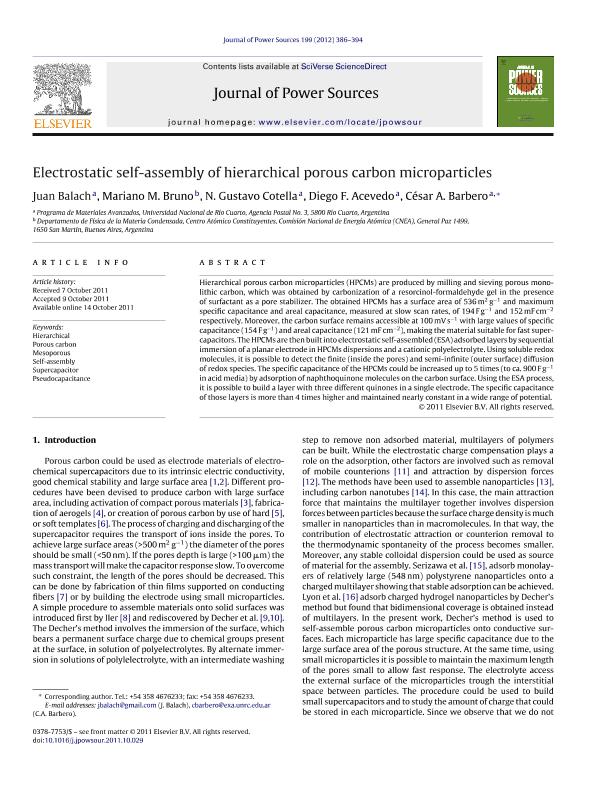Artículo
Electrostatic self-assembly of hierarchical porous carbon microparticles
Balach, Juan Manuel ; Bruno, Mariano Martín
; Bruno, Mariano Martín ; Cotella, Nelson Gustavo; Acevedo, Diego Fernando
; Cotella, Nelson Gustavo; Acevedo, Diego Fernando ; Barbero, César Alfredo
; Barbero, César Alfredo
 ; Bruno, Mariano Martín
; Bruno, Mariano Martín ; Cotella, Nelson Gustavo; Acevedo, Diego Fernando
; Cotella, Nelson Gustavo; Acevedo, Diego Fernando ; Barbero, César Alfredo
; Barbero, César Alfredo
Fecha de publicación:
02/2012
Editorial:
Elsevier Science
Revista:
Journal of Power Sources
ISSN:
0378-7753
Idioma:
Inglés
Tipo de recurso:
Artículo publicado
Clasificación temática:
Resumen
Hierarchical porous carbon microparticles (HPCMs) are produced by milling and sieving porous monolithic carbon, which was obtained by carbonization of a resorcinol-formaldehyde gel in the presence of surfactant as a pore stabilizer. The obtained HPCMs has a surface area of 536 m2 g-1 and maximum specific capacitance and areal capacitance, measured at slow scan rates, of 194 F g-1 and 152 mF cm-2 respectively. Moreover, the carbon surface remains accessible at 100 mV s-1 with large values of specific capacitance (154 F g-1) and areal capacitance (121 mF cm-2), making the material suitable for fast supercapacitors. The HPCMs are then built into electrostatic self-assembled (ESA) adsorbed layers by sequential immersion of a planar electrode in HPCMs dispersions and a cationic polyelectrolyte. Using soluble redox molecules, it is possible to detect the finite (inside the pores) and semi-infinite (outer surface) diffusion of redox species. The specific capacitance of the HPCMs could be increased up to 5 times (to ca. 900 F g-1 in acid media) by adsorption of naphthoquinone molecules on the carbon surface. Using the ESA process, it is possible to build a layer with three different quinones in a single electrode. The specific capacitance of those layers is more than 4 times higher and maintained nearly constant in a wide range of potential.
Archivos asociados
Licencia
Identificadores
Colecciones
Articulos(CCT - CORDOBA)
Articulos de CTRO.CIENTIFICO TECNOL.CONICET - CORDOBA
Articulos de CTRO.CIENTIFICO TECNOL.CONICET - CORDOBA
Articulos(SEDE CENTRAL)
Articulos de SEDE CENTRAL
Articulos de SEDE CENTRAL
Citación
Balach, Juan Manuel; Bruno, Mariano Martín; Cotella, Nelson Gustavo; Acevedo, Diego Fernando; Barbero, César Alfredo; Electrostatic self-assembly of hierarchical porous carbon microparticles; Elsevier Science; Journal of Power Sources; 199; 2-2012; 386-394
Compartir
Altmétricas



